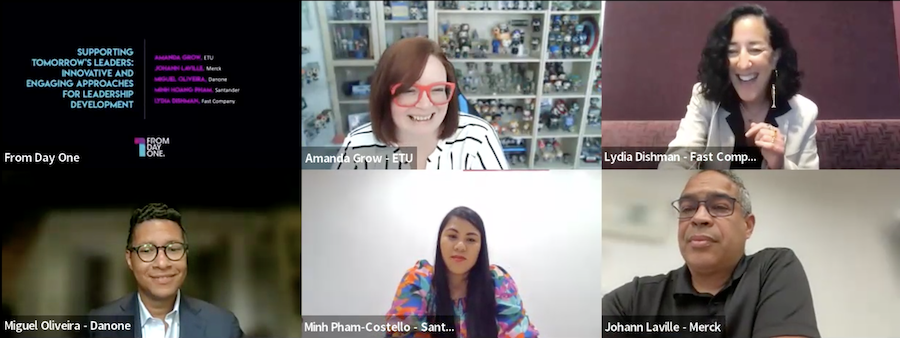Innovative and Engaging Approaches for Leadership Development


“The war for talent is over, and talent won.”
This was a quote that resonated with Miguel Oliveira, senior HR director supporting the brand management and marketing teams at Danone North America, he said during a recent From Day One webinar.
Leaders are now being evaluated “not only on the results they bring to the business, but on results from engagement, well-being, and retention,” he told moderator Lydia Dishman during a From Day One webinar about supporting tomorrow’s leaders.
Amanda Grow, director of customer success for ETU, says the company has leadership training programs centered on skills related to values such as authenticity and courage, emotional intelligence, and psychological safety.
“I always want to see inclusive and emotionally intelligent leaders, because that really does have a major impact on every organization and your culture and what you're trying to instill in your employees,” said Grow.
Things have changed tremendously in the workforce in recent years, which impacts what leadership looks like, says Johann Laville, the chief learning officer at Merck.
Remote work is becoming more commonplace, the workforce is younger and more diverse, and “technology is driving our future at light speed,” he said.
As a result, leaders are listening more and focusing more on leading with humility, he says.
Tips for Training Future Leaders
Early talent programs are a way companies can develop future leaders, says Minh Pham-Costello, vice president of business management at Santander. Employees can get an endorsement from their manager when applying.
It’s crucial to make sure the employee is committed to the program “because sometimes you push programs to people and they either don’t have the capacity or the desire,” Pham-Costello said. It is also important to have programs that cater to senior leaders’ professional development needs.
Programs for future leaders shouldn’t be one size fits all, according to Grow.
“It’s great to have a global skill set that we’re trying to adhere to, but we also need to dig down and go to the level deeper and really understand how those skills show up at different role levels, different proficiency levels, and more, so that you really can personalize some of the training,” said Grow. For example, a senior leader who takes a junior-level course probably won’t find it engaging.

Oliveira compared leadership training to trying to teach someone how to ride a bike. You can have trainees watch a movie on how to do it or “put them on a bike and have someone hold the bike to let them understand how it works,” he said.
When exposing employees with leadership potential to management fundamentals, “It’s really important to create ways and mechanisms to give them visibility to what it looks like without the responsibility of leading someone directly,” Oliveira said. “I still see today many people stepping into their first managerial leadership opportunity and they still lack those fundamentals, and unfortunately, those suffering are those reporting to the individual.”
How Employees Can Demonstrate Leadership Skills
Although organizations are investing in leadership development more than ever before, individuals still need to take the initial steps toward getting to the next level, says Pham-Costello.
“Of course, other people can help you, but when you take the initiative with your career, you are not only developing your skill but also showing the organization that you are committed to the company and to your growth,” she said.
Business resource groups (BRG) are essential when it comes to leadership development, says Pham-Costello. A BRG “gives you that visibility. People see you leading and influencing.”
Laville said Merck has a true gig economy. This means if an employee wants to demonstrate their capability of being an effective leader and there’s something they are passionate about – whether it’s a topic, division, or product – they can apply internally, be interviewed, and be selected.
That employee would then have support from the leader who releases them into the gig and the leader who would accept them “to come in and provide a new value,” Laville said.
Seeking mentorship is another way for those who wish to be leaders to get to that level. Mentors are “subject matter experts that you can have some really open conversations with to help guide you on that path,” he said.
Editor’s note: From Day One thanks our partner, ETU, for sponsoring this webinar.
Mary Pieper is a freelance writer based in Mason City, Iowa.
The From Day One Newsletter is a monthly roundup of articles, features, and editorials on innovative ways for companies to forge stronger relationships with their employees, customers, and communities.